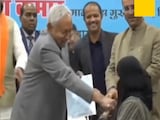Ever imagined walking on a river - not beside it, not across it, but on it? It is the Chadar Trek, India's most surreal winter experience. Set deep in the Zanskar region of Ladakh, the Chadar Trek is a test of endurance, a cultural passage, and a journey into a frozen world. Every winter, the Zanskar River transforms into a thick sheet of ice, forming a trail that locals have used for centuries. Today, it draws trekkers from across the globe who want to walk this icy path, sleep in caves, and witness frozen waterfalls suspended mid-air.
But this trek is not for the faint-hearted. With temperatures dropping to -30-degree Celsius and the terrain constantly shifting, preparation is key. Here is a guide that will help you understand everything, from itinerary and gear to safety, survival, and the cultural nuances of the region, so you can take on the Chadar with confidence.
Also Read: Ladakh Travel Guide: Where To Go, Eat, Shop, & Stay In India's Highest Playground
About Chadar Trek: Why It Draws Trekkers From Around The World
The word Chadar means "blanket", referring to the thick ice sheet that forms over the Zanskar River during peak winter. The trek spans around 105 kilometres, starting from Chilling and ending at Naerak, passing through dramatic gorges, frozen waterfalls, and remote Ladakhi villages.
Historically, this route was used by Zanskari villagers to reach Leh when roads were blocked by snow. Today, it is one of India's most iconic treks, often compared to Arctic expeditions for its extreme conditions and breathtaking beauty. The trek's combination of natural wonder and cultural history makes it a bucket-list adventure for trekkers seeking something beyond ordinary trails.
Also Read: Budget Travel To Leh-Ladakh In Just INR 20000
Photo Credit: Pexels
How To Reach The Starting Point:
Most trekkers begin their journey by flying into Leh, the capital of Ladakh, which is well-connected to major Indian cities like Delhi and Mumbai.
From Leh, it is an 8-10-hour drive to Chilling, depending on road conditions. Options for reaching Chilling include:
- Local taxis
- Shared cabs
- Trekking operators' transport services
It is important to plan your travel considering altitude acclimatisation. Arriving a few days early in Leh helps your body adjust to the high altitude and reduces the risk of altitude sickness during the trek.
Chadar Trek Itinerary: How Your Journey Unfolds
Most trekking operators follow a 9-day itinerary that balances acclimatisation and trekking:
Day 1: Arrive in Leh (3,500 metres). Rest and acclimatise.
Day 2: Acclimatisation and local sightseeing.
Day 3: Medical check-up and permit formalities.
Day 4: Drive to Shingra Yokma. Trek to Sumo.
Day 5: Trek to Tibb Cave.
Day 6: Trek to Nerak and witness the iconic frozen waterfall.
Day 7: Return to Tibb.
Day 8: Trek back to Shingra Yokma. Drive to Leh.
Day 9: Departure.
Each day combines trekking with moments to appreciate the landscape and interact with local communities, making it essential to follow the itinerary closely for safety and acclimatisation.
Also Read: What To Pack For Leh Ladakh Bike Trip: A Rider's Survival Kit For India's Toughest Road
Photo Credit: Pexels
Best Time To Do The Chadar Trek:
The ideal window is mid-January to early February, when the river is fully frozen and stable. Avoid late February as melting begins and the ice becomes unpredictable. Timing affects both safety and the quality of the frozen landscapes you will see.
Chadar Trek Challenges And Essentials:
The Chadar Trek is rated moderate to difficult. Trekkers walk 10-15 kilometres daily on slippery ice, navigate broken trails, and endure temperatures between -1-degree Celsius to -30-degree Celsius.
This trek demands:
- Strong mental resilience
- Good physical fitness
- Ability to adapt to extreme cold and high altitude
Essential gear includes:
- Gum boots (available in Leh)
- Layered thermal wear
- Waterproof gloves and socks
- Trekking pole
- Sunglasses and sunscreen
- Sleeping bag (sub-zero rated)
- Personal medication and first-aid kit
Pro Tip: Avoid cotton and stick to quick-dry, insulated gear. Pack light but smart to make the trek manageable without compromising safety.
How To Prepare For Chadar Trek: Fitness, Mindset And First-Time Tips
Start training 6-8 weeks before your trek:
- Brisk walks or jogs (5-10 kilometres daily)
- Stair climbing and squats for leg strength
- Breathing exercises for altitude adaptation
First-time trekkers should also:
- Acclimatise properly: Spend at least 48 hours in Leh before starting
- Walk flat-footed: Avoid heel strikes on ice to prevent slipping
- Stay hydrated: You may not feel thirsty, but dehydration is real
- Carry dry fruits and ORS: Energy dips are common
- Respect the locals and the land: This is their home, not just your adventure
Mental preparation is equally important. You must be ready for discomfort, cold, and isolation. In return, you gain moments of awe, silence, and self-discovery.
Also Read: Magnetic Hill In Leh: The Road Where Cars Seem To Roll Uphill On Their Own
The Permits And Medical Clearance Required:
Before you hit the ice, ensure you have:
- LAHDC permit (Ladakh Autonomous Hill Development Council)
- Medical certificate from Leh hospital
- Environmental fee (usually included in trek package)
Most operators handle paperwork, but trekkers must pass a fitness check before starting. These measures safeguard both participants and the environment.
Where Do You Stay During The Trek:
Accommodation arrangements include:
- Hotels in Leh for the first two nights
- Tents or caves during the trek
- Sleeping bags and mats provided by operators
Expert Insight: Expect basic facilities. No mobile network, no charging points, it will be just you, the ice, and the stars. This simplicity is part of the Chadar experience.
Photo Credit: Pexels
Local Culture And Community Insights:
The Zanskar region is home to resilient communities who have thrived in harsh winters for centuries. Trekkers often encounter villagers using ice bridges, carrying supplies, and practising traditional crafts. Respecting local customs and interacting politely with residents enhances the experience and offers a glimpse into Ladakhi life rarely seen by outsiders.
Photography Tips For Chadar Trek:
The Chadar Trek provides some of the most striking photographic opportunities:
- Capture early morning light on ice reflections
- Shoot frozen waterfalls from different angles to highlight scale
- Photograph cave nights with campfires to show warmth against cold
- Interact with locals to capture authentic cultural moments
- A good camera with a wide-angle lens and proper cold-weather battery management ensures you do not miss key moments.
How Much Does The Chadar Trek Cost:
Prices range from Rs. 22,000 to Rs. 30,000 depending on the operator and inclusions. Most packages cover:
- Stay in Leh
- Meals during trek
- Permits and medical check
- Guides and porters
- Transport to base camp
Understanding costs in advance helps avoid surprises and ensures a smoother trek.
Safety And Caution: Essential Guidelines
- Ice Can Crack: Always follow your guide. Never walk alone or ahead of the group.
- Altitude Sickness: Watch for symptoms like headache, nausea, or dizziness. Inform your trek leader immediately.
- Hypothermia Risk: Layer up and avoid wet clothes.
- Emergency Evacuation: Helicopter rescue is possible but expensive. Ensure your trek operator has contingency plans.
- Environmental Responsibility: Carry reusable bottles, avoid plastic and leave no trace.
- Emergency Contacts: Leh hospital (01982-255370), Police (100), Trek operator emergency helpline
Following these guidelines protects both trekkers and the fragile environment.
Also Read: 5 Scenic Night Treks In India That Are Perfect For Stargazing
What To Expect: The Experience In Moments:
- Daylight reflections on ice that look like glass
- Frozen waterfalls that defy gravity
- Cave nights with campfires and stories
- Local interactions that reveal Ladakhi resilience
- Moments of silence that feel spiritual
The combination of natural beauty and cultural encounters makes every step memorable.
Also Read: From Backpacks To Snacks: Your Complete Trekking Gear Guide
Is Chadar Trek Worth It?
Absolutely, only if you are ready for it. The Chadar Trek is not just about walking on ice. It is about entering a world where nature rules, silence speaks, and every step tells a story. It is cold, tough, and unpredictable, but what you will experience is beyond words.






